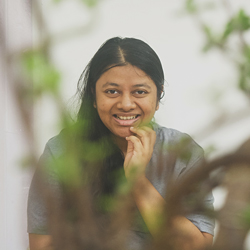Events

- This event has passed.
SCMS Award Winners – Graduate Student Colloquium
June 4 @ 3:00 pm - 5:00 pm
Pujita Guha, PhD
First Place, Graduate Student Writing Award, Media, Science, and Technology SIG
Counting Carbon in the Forest
 In the late 2000s, AIPP (Asia’s Indigenous People’s Pact), an Indigenous NGO body operating across south and southeast Asia, produced a series of training manuals, excel sheets and workshop materials, to train Indigenous activists and organizers on carbon trading and climate change. I call this body of carbon-related media AIPP’s carbon toolkit. AIPP’s carbon toolkit, while being cautious and wary of carbon trading as neoliberal greenwashing, imagines and produces a discourse of Indigenous carbon science by braiding contemporary western scientific forestry knowledge with ancestral ecological learnings of communities in upland Asia. I foreground here a Karen (Indigenous community in Northern Thailand) perspective on counting carbon in the forest, and their efforts to mobilize Indigenous knowledge to prove that swidden (slash-and-burn agriculture) and cultural burning of forests are in fact carbon-positive. That is, swidden stores more carbon than it generates by burning up a forest cyclically: which is a challenge to western’s science’s vilification of swidden as a forest destruction mechanism. I read AIPP’s work as a pragmatic process of quantifying the forest that can be used to serve the political needs of the community, and the continued practices of living intimately in forest. Pragmatism moves beyond critique into a space of action; and of creating ethical futures.
In the late 2000s, AIPP (Asia’s Indigenous People’s Pact), an Indigenous NGO body operating across south and southeast Asia, produced a series of training manuals, excel sheets and workshop materials, to train Indigenous activists and organizers on carbon trading and climate change. I call this body of carbon-related media AIPP’s carbon toolkit. AIPP’s carbon toolkit, while being cautious and wary of carbon trading as neoliberal greenwashing, imagines and produces a discourse of Indigenous carbon science by braiding contemporary western scientific forestry knowledge with ancestral ecological learnings of communities in upland Asia. I foreground here a Karen (Indigenous community in Northern Thailand) perspective on counting carbon in the forest, and their efforts to mobilize Indigenous knowledge to prove that swidden (slash-and-burn agriculture) and cultural burning of forests are in fact carbon-positive. That is, swidden stores more carbon than it generates by burning up a forest cyclically: which is a challenge to western’s science’s vilification of swidden as a forest destruction mechanism. I read AIPP’s work as a pragmatic process of quantifying the forest that can be used to serve the political needs of the community, and the continued practices of living intimately in forest. Pragmatism moves beyond critique into a space of action; and of creating ethical futures.
Josh Baldelomar, MA/PhD
First Place, Graduate Student Writing Award, Experimental Film and Media SIG
Experimental Film or Filmed Experiment? Sensory Control and the Spectator as Lab Rat
 This paper analyzes how the laboratory rodent has served as a figure of interest in both scientific films and experimental cinema. On one hand, it examines the lab rodent as a subject of experimentation and knowledge-making in scientific films, linking the research frameworks these films were part of to their aesthetics and formal choices. On the other hand, it explores the lab rodent as an evocative figure in experimental films, drawing parallels between the manipulation of the film medium and the treatment of the animal itself. The paper argues that, despite their distinct purposes, these films overlap in the ways they foreground the textural presence of lab rodents under experimentation. Through close reading, discourse analysis, and archival research, this paper situates these films within their respective contexts and contends that they create a viewing experience that constellates seeing the lab rodent as an abstract figure with recognizing it as a sentient animal. Because these films prompt spectators to identify with the lab rodent, the paper argues that they offer a way to consider how scientific work—despite training viewers to adopt a scientifically acceptable gaze—can position spectators themselves as experimental subjects.
This paper analyzes how the laboratory rodent has served as a figure of interest in both scientific films and experimental cinema. On one hand, it examines the lab rodent as a subject of experimentation and knowledge-making in scientific films, linking the research frameworks these films were part of to their aesthetics and formal choices. On the other hand, it explores the lab rodent as an evocative figure in experimental films, drawing parallels between the manipulation of the film medium and the treatment of the animal itself. The paper argues that, despite their distinct purposes, these films overlap in the ways they foreground the textural presence of lab rodents under experimentation. Through close reading, discourse analysis, and archival research, this paper situates these films within their respective contexts and contends that they create a viewing experience that constellates seeing the lab rodent as an abstract figure with recognizing it as a sentient animal. Because these films prompt spectators to identify with the lab rodent, the paper argues that they offer a way to consider how scientific work—despite training viewers to adopt a scientifically acceptable gaze—can position spectators themselves as experimental subjects.
Zach McLane, MA/PhD
Honorable Mention, Graduate Student Writing Award, Media, Science, and Technology SIG
Delinquent Looks: Gaze Detection, Trustworthiness, and the Science of Cheating
 As 2020’s COVID-19 lockdowns swept the world, many universities adopted online test proctoring software such as Respondus Monitor, ProctorU, and Proctorio to administer remote exams. Although many universities have since rolled back the use of such software, its use in remote education contexts began over ten years before the pandemic and its market is expected to continue to grow. Taking up this software as both a media object and technology of measurement, this presentation considers the mediated processes under which delinquency, judgment, and trustworthiness are produced through data collection. Focusing specifically on the technology of “gaze detection,” I bring it into conversation with methods for determining juvenile delinquency used during the first mass adoption of intelligence testing in the United States, which took place in the early twentieth century. I investigate how researchers sought to measure morality while advancing a eugenicist program. Attending to both trustworthiness tests of the 1920s and current automated gaze detection, I consider how these technologies for detecting cheating ultimately produce the very subject who cheats.
As 2020’s COVID-19 lockdowns swept the world, many universities adopted online test proctoring software such as Respondus Monitor, ProctorU, and Proctorio to administer remote exams. Although many universities have since rolled back the use of such software, its use in remote education contexts began over ten years before the pandemic and its market is expected to continue to grow. Taking up this software as both a media object and technology of measurement, this presentation considers the mediated processes under which delinquency, judgment, and trustworthiness are produced through data collection. Focusing specifically on the technology of “gaze detection,” I bring it into conversation with methods for determining juvenile delinquency used during the first mass adoption of intelligence testing in the United States, which took place in the early twentieth century. I investigate how researchers sought to measure morality while advancing a eugenicist program. Attending to both trustworthiness tests of the 1920s and current automated gaze detection, I consider how these technologies for detecting cheating ultimately produce the very subject who cheats.